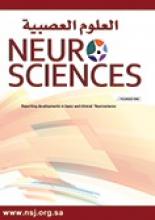Abstract
OBJECTIVE: To explore the effects of edaravone on the expression of matrix metalloproteinase-9 (MMP-9) posterior to cerebral hemorrhage, and to analyze the relationship between this expression and neurological deficit.
METHODS: A total of 160 basal ganglia hemorrhage patients enrolled in Dongfeng Hospital, Hubei University of Medicine, Shiyan, China between April 2009 and July 2011 were included and divided into a treatment group and a control group (n=80). All patients were treated with minimally invasive hematoma evacuation, and the treatment group was administered with edaravone simultaneously. Serum MMP-9 levels were measured by double-antibody sandwich enzyme-linked immunosorbent assay. The National Institutes of Health Stroke Scale (NIHSS) and Glasgow Coma Scale scores of the 2 groups were determined before and after treatment.
RESULTS: The overall effective rates of the treatment (86.3%) and control (75.0%) groups differed significantly (p<0.05). The serum MMP-9 levels of the 2 groups that were similar (p>0.05) before treatment significantly decreased (p<0.05) after treatment, and those of the 2 groups also differed significantly (p<0.05). The NIHSS scores of the 2 groups that were similar (p>0.05) before treatment also significantly decreased (p<0.05) after treatment, and those of the 2 groups differed significantly (p<0.05). Pearson’s correlation analysis revealed that the level of serum MMP-9 was significantly correlated with the NIHSS score before treatment (R=0.491).
CONCLUSION: Combined minimally invasive hematoma evacuation and edaravone effectively treated cerebral hemorrhage by directly lowering the level of serum MMP-9.
- Copyright: © Neurosciences
Neurosciences is an Open Access journal and articles published are distributed under the terms of the Creative Commons Attribution-NonCommercial License (CC BY-NC). Readers may copy, distribute, and display the work for non-commercial purposes with the proper citation of the original work.






